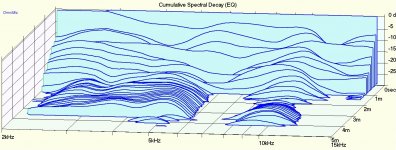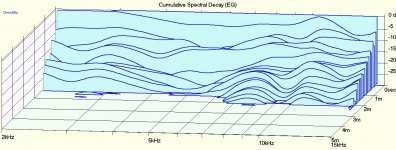yeah sure... flat to 20Hz. from an OB. in the 5.6 cab, 20Hz is at -20dB
even with two 15" woofers, in an OB you'd need +10dB boost.
in that case, i am not in in the least awed, i can do that with my 12" speakers too.
even with two 15" woofers, in an OB you'd need +10dB boost.
in that case, i am not in in the least awed, i can do that with my 12" speakers too.
I am not in awe of frequency response either.
There is a lot more to it than just flat frequency response.
In regard to flat frequency response the PHY OB is the clear winner, which isn't a surprise given the size of it, but it also tends to give a smoother response with out many troughs or peaks
The funny thing is I tend to like the smaller OB more. I need to verify that with more listening tests though
There is a lot more to it than just flat frequency response.
In regard to flat frequency response the PHY OB is the clear winner, which isn't a surprise given the size of it, but it also tends to give a smoother response with out many troughs or peaks
The funny thing is I tend to like the smaller OB more. I need to verify that with more listening tests though
Last edited:
Member
Joined 2009
Paid Member
I expect the smaller baffle suffers less from reflections between baffle and the front wall, that is is also more rigid and less susceptible to colour the sound, after all the larger baffle only has to have a bit of parasitic vibration to be heard since it has an area much larger than the cone ?
I am going to cut the height down of the PHY to 1.2m and see what happens. That should give me a better idea
Regarding CS2.3, I will try and build it this weekend and see what sought of bass improvement I might get
No kidding. That was going to be my baby, but lets face it, i have enough kids. I turned down some second hand AN 12 cast. Really want the 15's. I have to pull out my Alpair 12.2's and get to work. They have just received some very positive feedback in OB setup. Too much to do and too little time.
People like their dipole front wall bounce, most don't like it blocked.
Dipoles 6' from the front wall sounded best to me, otherwise too much blend.
And the smaller 3 driver ob should do bass better.
My 6.5" with piezo crossed at 5khz doesn't have a problem running wide open alongside a pair of subs 18db@80hz at my usualy listening volumes (little louder than tv). Putting my hand lightly on the cone, I'm suprised it isn't more garbled than it is.
Norman
Dipoles 6' from the front wall sounded best to me, otherwise too much blend.
And the smaller 3 driver ob should do bass better.
My 6.5" with piezo crossed at 5khz doesn't have a problem running wide open alongside a pair of subs 18db@80hz at my usualy listening volumes (little louder than tv). Putting my hand lightly on the cone, I'm suprised it isn't more garbled than it is.
Norman
Last edited:
It does seem that a smaller baffle tends to create a greater feeling of having the performer in your room. I am not ready to make that conclusion though.People like their dipole front wall bounce, most don't like it blocked.
Dipoles 6' from the front wall sounded best to me, otherwise too much blend.
Norman
I will cut down the PHY and see what happens
Last edited:
This thread is more about playing with different types of open baffle designs, not necessarily about any specific full range driver
Well in that case I have a driver alignment question that I have never seen implemented before in OB, something I've been looking to try.
What if we started with a decent quality dual voice coil, high excursion driver. Something like the 15" Dayton DVC seen here: Dayton Audio DVC385-88 15" DVC Series Subwoofer 295-190
Instead of implementing DSP or altering Q by adding resistance, we drove one of the two coils with a clean BASH style plate amp. The 2nd coil was driven normally by our full range source amplifier. The balance between the two would determine low end compensation that could be dialed-in at will.
This particular driver should be crossed low passively to a capable HF driver; something like a ScanSpeak D2604 with it's 475Hz Fs selling for a mere $53... or possibly even a CD. I would propose mounting the driver low, angled up toward the listener. We might effectively wind up with a compact 2 driver OB with lots of possibilities for not a lot of coin?
I am not that familiar with the construction of dual voice drivers. I am not sure how wiring up separate amps to each voice coil would be a good idea.
I like the idea of the D2604 but I honestly think once you have heard good sounding high efficiency drivers you won't go back.
My scanspeak 2.5 ways are in the garage
EDIT: I would be still happy to play around with this idea though. I would choose the Usher 9950-20 though over D2604 tweeter in terms of bang for buck
I like the idea of the D2604 but I honestly think once you have heard good sounding high efficiency drivers you won't go back.
My scanspeak 2.5 ways are in the garage
EDIT: I would be still happy to play around with this idea though. I would choose the Usher 9950-20 though over D2604 tweeter in terms of bang for buck
Last edited:
Interesting idea. About woofer placement, I have played with different simulators about woofer positioning and you can get much more even roll off by moving the woofer off the ground about 20". I remember Joachim Gerhard mentioning this and saying that he thought ther was better balance in the response when this path was taken. I know a lot of folks shove the woofer down low for Fluor boost, but there is consideration needed for the side effects of this
This particular driver should be crossed low passively to a capable HF driver; something like a ScanSpeak D2604 with it's 475Hz Fs selling for a mere $53... or possibly even a CD. I would propose mounting the driver low, angled up toward the listener. We might effectively wind up with a compact 2 driver OB with lots of possibilities for not a lot of coin?
The fostex ff85wk is the perfect driver for your application
CSD PLOTS Seas FA22 vs Radian 475pb
Radian clearly superior to Seas FR
Probably unfair test, but interested to know how it compares
I am now keen to try ENabl on the Seas and see how it may improve things
The first plot is Seas FA22 and the second is Radian475pb
Radian clearly superior to Seas FR
Probably unfair test, but interested to know how it compares
I am now keen to try ENabl on the Seas and see how it may improve things
The first plot is Seas FA22 and the second is Radian475pb
Attachments
Last edited:
I am not that familiar with the construction of dual voice drivers. I am not sure how wiring up separate amps to each voice coil would be a good idea.
I like the idea of the D2604 but I honestly think once you have heard good sounding high efficiency drivers you won't go back.
My scanspeak 2.5 ways are in the garage
EDIT: I would be still happy to play around with this idea though. I would choose the Usher 9950-20 though over D2604 tweeter in terms of bang for buck
And I have one 9950-20 on the shelf. Truly a neutral sounds tweeter that can be crossed fairly low.
I am not that familiar with the construction of dual voice drivers. I am not sure how wiring up separate amps to each voice coil would be a good idea.
EDIT: I would be still happy to play around with this idea though. I would choose the Usher 9950-20 though over D2604 tweeter in terms of bang for buck
The main purpose of DVC is wiring flexibility, as these drivers can be wired in series, parallel or only one coil, resulting in lets say 2, 4, or 8 ohms depending on each coils value. But I know of no reason why I couldn't send the same signal, crossed differently and at different levels to each of the coils, in order to balance the levels in a dipole app. The result should be a cancellation compensated single cone/single point source driver from say 1000Hz down.
Last edited:
- Status
- Not open for further replies.
- Home
- Loudspeakers
- Full Range
- Melon Head's State of the "DUMB" Open Baffle Design

